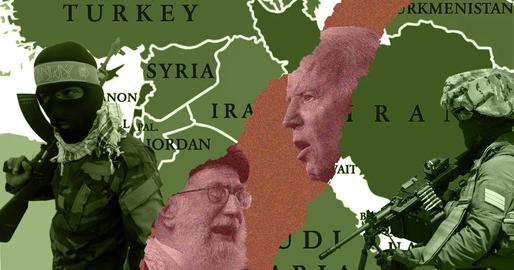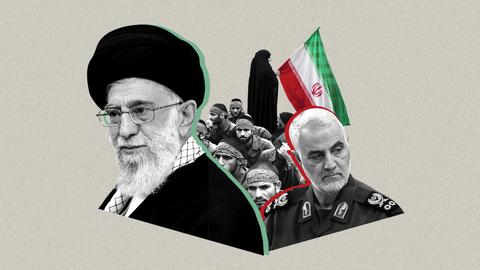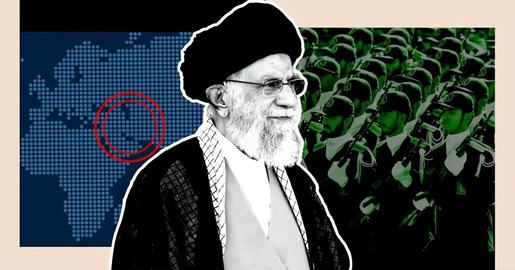The United States targeted Iran's proxy forces in eastern Syria just hours after Joe Biden issued a direct warning to Iran's Supreme Leader Ali Khamenei.
Attacks by militias supported by the Islamic Republic of Iran against American forces in Iraq and Syria have escalated since the conflict between Israel and the Hamas terrorist group started on October 7.
The overnight US strikes, authorized by President Biden, were the first American response to what Defense Secretary Lloyd Austin said were a number of attacks against US personnel and facilities in Iraq and Syria by Iranian-backed militias over the past two weeks.
The Pentagon said the bases hit were used by these militias and described the strikes as self-defense measures separate from its military support for Israel.
It happened less than 48 hours after Biden's unprecedented address to Ali Khamenei during a White House news conference.
"My warning to the Ayatollah was that, if they continue to move against those troops, we will respond, and he should be prepared. It has nothing to do with Israel," he said alongside visiting Australian Prime Minister Anthony Albanese.
The United States then proceeded to target Iran's proxy forces in eastern Syria, leaving seven people wounded, according to local media in Syria.
The attack is not intended to eliminate these forces; instead, its purpose is to serve as a warning to the Iran’s Supreme Leader and to demonstrate the resolve of the United States, which the Islamic Republic perceives as a declining power.
In recent days, some US senators, American think tanks, and government analysts in Washington have recommended that the Biden administration abandon the policy of '"appeasement with the Islamic Republic," which they believe has proven "ineffective."
Before the outbreak of hostilities between Israel and Hamas, the Israeli air force had targeted Iranian militia positions, particularly in Syria, which shares a border with Israel.
The last time the US government carried out airstrikes against these positions was at the beginning of the Biden administration, approximately 30 months ago.
Following Hamas's shock attack on Israel, the Islamic Republic issued a warning, declaring that its militias in the region, collectively known as the "Axis of Resistance," would respond to Israel's ground offensive in Gaza.
Three days after the Hamas attack, Khamenei said that the Islamic Republic was not responsible for the attacks and suggested that Hamas had acted unilaterally to avoid attributing responsibility to the Iranian government.
However, with the ongoing conflict, rocket fire, and Hamas attacks, as well as the potential for the Israeli army to enter Gaza, Khamenei's tone quickly shifted.
In his statements, this time serving as a clear indication that the militants were under control in the region, he initially held the United States "mainly responsible" for Israel's actions.
He then issued a warning that if the attacks on Gaza persisted, "Muslims from around the world and the resistance forces will grow impatient, and no one will be able to deter them."
As the conflict between Hamas and Israel continues, militias supported by the Islamic Republic have significantly intensified their own attacks.
In the second week of the war between Hamas and Israel, the US Department of Defense reported that its forces were targeted at least 12 times in Iraq and four times in Syria.
Yemen's Houthi rebels, who receive financial and military support from the Islamic Revolutionary Guard Corps (IRGC), used a drone to attack an American ship in the Red Sea.
The attack did not harm US forces due to the successful interception and destruction of the drone. However, it serves as evidence of the motivation and indirect efforts of the Islamic Republic against the United States in various regions.
The Islamic Republic supports proxy groups in Iraq, Syria, Lebanon, and Yemen. The US has targeted some of the militias that receive financial support, training, and arms from the IRGC, in the past week.
According to the Syrian Observatory for Human Rights, these militias number around 15,000 fighters.
Th militias are primarily located in the region between Abu Kamal and Deir ez-Zor, which is close to the border with Iraq.
The area provides a strategic location for sending weapons and transferring IRGC forces from inside Iran via land routes.
Qassem Suleimani, then commander of the Quds Force of the IRGC's overseas branch, who was killed in a January 2020 US air strike on his position in Baghdad, was present in Abu Kamal for an extended period during the height of the Syrian civil war, where he directly commanded battlefield operations.
Following his departure from Abu Kamal, a letter from him was published, addressed to the owner of the house that he had used as the headquarters of his command.
The Fatemiyoun Brigade is another militia group, comprising Afghan refugees and immigrants who have been trained and armed by the IRGC. It forms the core of the militias under Islamic Republic control in Syria.
Additionally, the Zeinabiyoun Brigade consist of Pakistani Shia fighters who have been integrated into the militias supported by the IRGC in Syria.
These groups have been further bolstered by the addition of Iraqi Shia militias, primarily from Kataib Hezbollah in Iraq, forming a larger militia organization in eastern Syria, comprising at least four militias.
Iran has used various methods for providing support to these militias, including sending weapons by air and transferring trained personnel or commanders to Syria via air travel.
Additionally, they use land routes through Iraq to deliver weapons to Syria.
Over the past decade, Israel has targeted these supply trucks on multiple occasions, and on one occasion the US military under the Biden administration also targeted these assets.
The strategy of the Islamic Republic, after cooperating with the United States to remove Saddam Hussein's regime in Iraq, has involved supporting militias that have launched continuous attacks on the United States.
Their aim was to turn Iraq into what some called "America's swamp" and to mire the United States a situation akin to the Vietnam War.
This strategy extended to Syria as well, particularly with the limited presence of American forces in that country.
During Donald Trump's presidency, from 2016 to 2020, several strong reprisals were carried out by the US in response to Iran-backed incidents.
After the death of an American contractor in Iraq, the airstrike against Qassem Suleimani, commander of the IRGC’s expeditionary Quds Force, resulted in his death and in the death of an Iraqi commander of Iranian-backed militias.
In response to the killing of Suleimani, Iran's Supreme Leader, Ali Khamenei, declared that the Islamic Republic would seek revenge by expelling US military forces from the region, primarily through the use of militia groups.
The overnight attack on October 26, which occurred after a public warning from Secretary of State Anthony Blinken, was not directly related to the conflict between Hamas and Israel, and the US expressed its reluctance to see the conflict escalate.
"We are concerned at the possibility of Iranian proxies escalating their attacks against our own personnel, our own people," Blinken said during an interview with CBS on Sunday.
"We're taking every measure to make sure that we can defend them and if necessary, respond decisively," he said.
While the United States characterizes its defensive actions against militias backed by the Islamic Republic as separate from the conflict in Israel, it appears that the Islamic Republic has adopted a new policy, as articulated in recent speeches by Khamenei and Hossein Amir-Abdollahian, the Minister of Foreign Affairs.
Amir-Abdollahian made a clear declaration during an emergency session of the United Nations General Assembly this week when he said, "To the Israeli warmongers and their supporters, to the American statesmen and soldiers currently overseeing a genocide in Palestine, I unequivocally do not welcome the expansion and scope of the conflict," he said.
"If the Gaza crisis persists, they will not be immune to the consequences. This region is our home. West Asia [the Middle East] is our domain. We will not compromise on safeguarding our interests."
According to the United Nations Charter, some observers have suggested, Amir-Abdollahian’s tone constituted a "threat to use force” which the Islamic Republic had refrained from doing before Hamas's attack on Israel.
However, it is evident that, from the perspective of Khamenei and the Iranian government, the regional situation has evolved to the point where they are openly threatening Israel and the United States with armed conflict, even speaking from New York, seemingly relying on the strength of their militia forces.
In contrast, the United States, in its defense doctrine and legal interpretation of the United Nations Charter, does not equate the threat of force with the actual use of force, differing from some other countries.
However, the situation concerning Israel, now embroiled in a conflict with Hamas, is different and could elicit a response from the US as event continue to intensify and escalate.
Furthermore, the militia groups supported by the Islamic Republic, not being recognized as state actors and not adhering to international laws and regulations, may inadvertently provoke actions for which the Islamic Republic would bear responsibility due to its support, potentially leading to an abrupt escalation of the conflict.
visit the accountability section
In this section of Iran Wire, you can contact the officials and launch your campaign for various problems

























comments